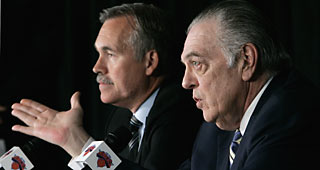As the off-season drags on with both David Lee and Nate Robinson remaining unsigned, there has been much speculation that the two restricted free-agents could take one-year contracts with the Knicks, only to be cut loose next summer as the team pursues a superstar free-agent who would demand a maximum contract.
An examination of the relevant salary cap figures shows that the Knicks' ability to retain Lee or Robinson may end up being a close call even if the cap drops as expected.
If the Knicks do not sign Ramon Sessions or add any other 2010-2011 salary, team president Donnie Walsh will have approximately $4.1 million of cap room after one hypothetical max contract, under the league?s worst-case projection of a drop in the salary cap next summer to $50.4 million. With 10.5% annual raises, $4.1 million of cap room may be sufficiently large to retain Robinson.
If the cap is set at the league?s best-case projection of $53.6 million, the Knicks would have $7.3 million remaining after one max contract, which may be a big enough first-year salary to retain Lee on a potential six-year deal at 10.5% annual raises. Walsh could also try to create about $1 million to $4 million of additional cap room by buying out the contracts of Jared Jeffries and/or Eddy Curry, who may just prefer to seek new long-term contracts in 2010 rather than incurring the risk of unfavorable changes to the CBA in 2011. Jeffries and Curry could make up the 2010-2011 salary reduction in their new contracts. And because each player will be in the last year of his contract, the Knicks would save dollar-for-dollar 2010 cap relief on any difference between the buyout and the salary due.
If Lee signs with the Knicks for one season in the coming weeks, his sizable 2010 cap hold would prevent the Knicks from having the room to sign a free-agent to a maximum contract. However, note that Lee?s cap hold would immediately be replaced with the actual 2010-2011 salary figure if and when he were to sign a new contract with the Knicks next summer. For example, if the Knicks know that they have $7.3 million to offer Lee while still having the room to offer one max contract (which will come out to about $16.57 million for LeBron James, Dwyane Wade or Chris Bosh), the team can first sign the deal with Lee in order to convert his cap hold to the $7.3 million contract amount, then comfortably ink one max contract.
Of course, things don't always play out so sequentially in actual practice. In the summer of 2005, the Cavs were forced to renounce Zydrunas Ilgauskas in order to make room to sign then-free-agent Larry Hughes. The Cavs did end up re-signing Ilgauskas later, simply using their leftover cap room rather than his Bird exception. But that would not be the ideal scenario for anybody involved. For instance, if Walsh is able to squeeze Lee in at $7.3 million in year one, the two sides could want to take advantage of the added 2.5% of annual raises and an extra sixth year in order to make the most attractive and lucrative deal possible. Those advantages are lost once the player?s Bird rights are renounced as was the case with Ilgauskas in 2005.


